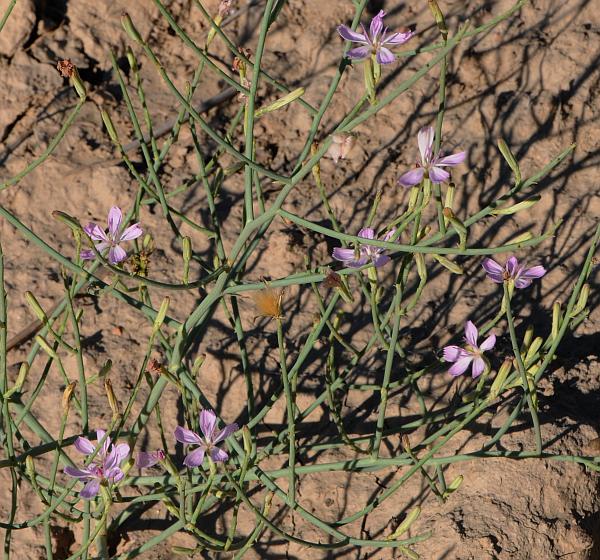Lygodesmia juncea (Pursh) D. Don ex Hook.
Skeleton Plant

Native
CC = 10
CW = 5
MOC = 5
© SRTurner
Lygodesmia juncea (Pursh) D. Don ex Hook.Skeleton Plant | |
 |
Native CC = 10 CW = 5 MOC = 5 |
© SRTurner |
|
Family - Asteraceae/Cichorieae Habit - Perennial forb, with deep-set, woody, usually vertical rootstock and branched rhizomes. Latex cream-colored or pale yellowish. Stems - Loosely ascending to erect, to 70 cm, usually highly branched, glabrous, often glaucous, finely longitudinally ridged, grayish green. Leaves - Basal and alternate, sessile, entire, glabrous. Basal leaves relatively few, 15-40 mm long, linear or very narrowly lanceolate, withering before the flowers develop. Stem leaves 1-12 mm long, scalelike, linear to very narrowly triangular, mostly withering or shed before the flowers develop. Venation of 1 or 3 main veins, sometimes not apparent. Inflorescence - Heads solitary at the branch tips or rarely lateral along the branches, appearing sessile to long-stalked.
Heads - Involucre 10-16 mm long at flowering, narrowly cylindrical, the bracts in 1 long, inner series and 3 or 4 shorter, outer series, those of the outer series 9-19, variously 1-4 mm long, narrowly triangular, usually purplish-tinged toward the tip, glabrous or hairy along the margins; those of the inner series more or less equal, 5-7, narrowly oblong-lanceolate, the margins often thin and pale, the tip appressed-ascending, often purplish-tinged. Receptacle naked but with minute, scaly ridges between the florets. Ligulate florets 4-6 per head.
Florets - Perfect. Corollas 12-20 mm long, usually lavender, usually 5-notched at tip. Pappus 6-9 mm long, of numerous apparently smooth (microscopically barbed) bristles, straw-colored to pale tan, persistent at fruiting. Style purplish, bifurcate. Anthers connate around style, purplish, to 4 mm long. Disk florets absent.
Fruits - Viable fruits not produced. Flowering - June - September. Habitat - Loess hills prairies and bluffs. Origin - Native to the U.S. Lookalikes - None close. Other info. - This interesting native is rare in Missouri, found only in the loess hills in the far northwest corner of the state. In fact, Missouri is at the extreme eastern boundary of the plant's range. It is much more common throughout the Great Plains. It is easily recognized by its wiry, leafless stems and its flower heads, which are unusual for members of this family in that they contain only a few florets. Photographs taken in Sherman County, KS, 8-29-2013 (SRTurner). |